Update, 7:45 a.m. Thursday: The MyShake test alert you might have received on Thursday morning at 3:19 a.m. was a mixup between time zones in the test alert system, according to USGS. The real test alert is still scheduled for 10:19 a.m. Thursday.
Update, 12:00 p.m. Wednesday: The emergency alert you might have received on Wednesday morning at 9:30 a.m. was for a real 4.2 magnitude earthquake just east of the Bay Area city of Antioch, near Isleton in Sacramento County. The MyShake emergency alert test detailed below is unrelated and should still go ahead as scheduled on Thursday morning.
Wednesday morning’s earthquake was initially overestimated as having a 5.7 magnitude by ShakeAlert USGS, which triggered the WEAS emergency alert on our cellphones. Ultimately, the earthquake’s magnitude was downgraded to 4.2.
“Our goal is public safety. And so yes, there are going to be events that will be overestimated because every earthquake is a little different,” said Robert-Michael de Groot, coordinator at ShakeAlert Earthquake Early Warning System, USGS. “The most important point about the earthquake early warning system is public safety. We try to maximize public safety.”
De Groot said the fact that MyShake overestimated the magnitude of this quake is “the system doing what it does normally.”
Original story: Do you have the MyShake earthquake warning app downloaded on your cellphone?
Over 2 million Californians already do — and they’ll be getting a loud earthquake test alert on Thursday morning, as part of the Annual Great ShakeOut quake preparedness drill that takes place across the globe.
This alert is coming on the heels of a test of the FEMA emergency alert system that was sent to phones nationwide. Keep reading for what you need to know about this latest test alert — and more ways to get these earthquake warnings for real.
When will the MyShake earthquake test alert happen?
The MyShake app will be sending the test alert on Thursday, Oct. 19 at 10:19 a.m. PST.
Unlike that FEMA test alert that almost everyone experienced earlier this month, this phone alert will only apply to people with the MyShake app living in California, Oregon and Washington.
What will the alert look and sound like?
The MyShake test alert will be in the form of an image that will tell people to “Drop, Cover, and Hold On.” You’ll also get an audio alert that will signify that this is a test.
